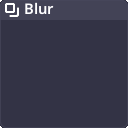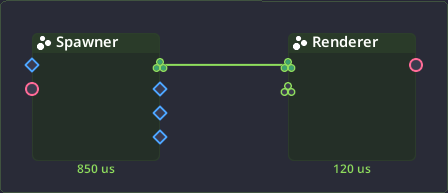Nodes basics

Nodes are the fundamental building block for Pixel Composer. Each nodes represent an operation with inputs and outputs, and connections between nodes represent the flow of data.
Terminologies
Nodes

Node represent an operation. It takes inputs, process them, and returns outputs. In graph, node inputs will appear on the left side, and outputs will appear on the right. This means the data will flow from left to right.
Properties
The node inputs, outputs are also called "Properties". Properties are elements you can see in the inspector panel. Input properties can be modify, animated or connected from output properties.
Junctions

See Junctions page for more detail.
Each property can be represent in the graph panel as a junction. The junction shape and color depends on the data behind it. Knowing the junctions will help you understand the data flow in the graph and making it easier to debug your graph.
Connections
A connection can be done from output junction to input junction. You can't connect two junctions from the same node, and you can't create cycle. For more information about junction type compatibility, check out the Junction page.
Array Processor
See Array Processor page for more detail.
Some node with the  icon are array processor. Array processor can batch process array of data. For example:
you can insert array of surfaces and have it all process at the same time.
icon are array processor. Array processor can batch process array of data. For example:
you can insert array of surfaces and have it all process at the same time.
Node Group

You can group multiple nodes by pressing Ctrl+G in the graph panel. Groupped node can be enter with double-click. Inside a group, you can create Group Input/Output node to interface with the outside context.
Inline Group

Some nodes, such as VFX, RigidSim, FluidSim, will create it's own context area called inline group. Right-clicking in theose area will allow you to create node that can't be created outside of the inline group.
Cache Group
Cache, Cache Array node will also create their own inline group called cache group. Nodes in cache group will be disabled once the all the values are cached, and they will be enabled if any property is changed to record the new values.
Actions

Some nodes comes with inspector actions that can be manually trigger in the inspector panel. Those action can be display as a junction for automation.
Cache
Some nodes store (cache) value of all frames for performance or to achieve some effects. Cache status will appear when inspecting a node at the animation panel.

The red bar means that frame has not been cached yet, green means the frames is cached.
Cache will automatically refresh if any properties is changed. However sometime you might want to clear the cache manually. You can do so by clicking the "Clear Cache" button in the inspector.

Attributes
Node attributes are extra properties that cannot be animated. These are mostly general controls such as texture interpolation, color space, etc. Attributes can be view in the setting tab in the inspector.
| Color depth | Set color depth for the surface.
|
| Texture interpolation | Set how the pixel color is being sampled at decimal position.
|
| Oversample | Set what color to sample outside the texture.
|
| Array process type | Set how array processor process multiple array inputs. |
Tools

Some nodes also come with tools which allow for interaction directly from the preview panel. Node tools will appear when the node is inspecting. Which means you can display tools while previewing another nodes.